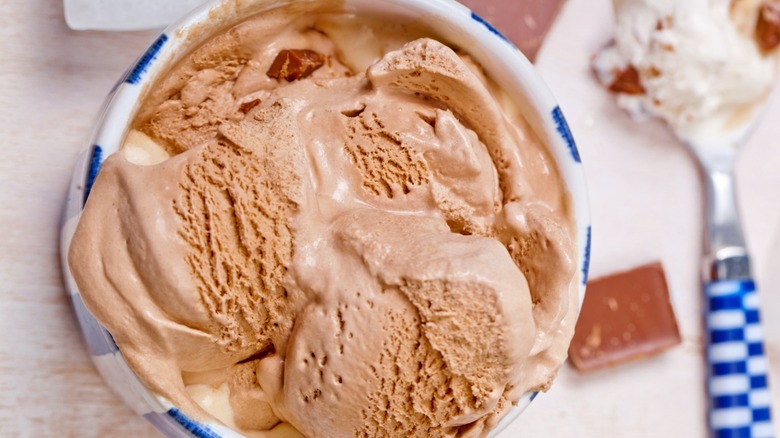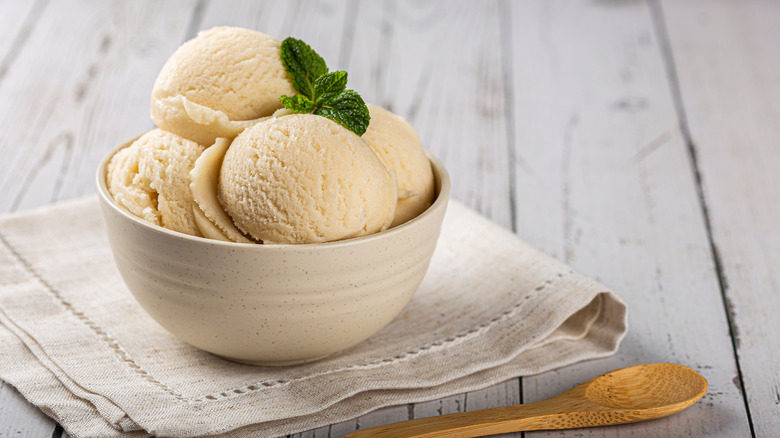What Makes New England-Style Ice Cream Unique
All ice cream is not created equal. From sorbets to hard custards, the texture and taste of ice cream will vary depending on where and how the treat is made. And it's not just the kind of flavor that makes a difference when it comes to enjoying a freshly scooped bowl; the mouthfeel and chew of ice cream can help contribute to a dessert recipe that is difficult to put down.
While sorbets deliver an icier, grittier texture to enjoy, New England-style ice cream is chewy and dense. Well-known brands like Ben & Jerry's have helped put this style of ice cream on the map for ice cream lovers worldwide, but plenty of other farms, dairies, creameries, and small businesses in the region have been churning out ice cream pints and handing over cones for connoisseurs to dig into for centuries. The American area is famously known for its high consumption of ice cream for good reason, but what makes ice cream from New England so good, exactly?
How New England-Style ice cream is made
Ice cream from New England typically has a higher milk fat content and lower air density, so the spoonfuls you eat are creamier and a bit stickier compared to ice creams made with different recipes. The U.S. Department of Agriculture outlines that ice cream varieties must be made up of at least 20% milk solids and 10% milk fat, yet ice cream makers can choose how to finish their recipes. With a higher fat content than other ice creams, New England-style ice cream makers can experiment with building more complicated flavors.
While regular ice cream usually contains about 10% milk fat (low-fat ice creams hang around 3%), New England ice creams climb towards the 18% range and are described as low-overrun products. Overrun refers to the amount of air an ice cream contains: Less air means more room for other ingredients like butterfat, offering a denser ice cream experience. Plus, New England ice creams are made slowly, intentionally churned at low mixing speeds so that less air is added to the ice cream. Like in frozen custards, New England ice creams also contain egg yolks, which makes the dessert even denser and helps create a smooth texture and rich flavor.
To replicate a similar consistency when making ice cream at home, don't be shy about incorporating heavy creams and full-fat milk into your culinary creations. Adding evaporated milk and arrowroot powder can help you build that chewy texture in the comfort of your own kitchen, and don't forget to add plenty of egg yolks for a true New England kind of ice cream recipe.
What makes New England-Style ice cream different
You'll notice that when you bite into ice cream that is made New England-style that a creamier, gummier texture hits your mouth. While this luxurious mouthfeel can seem to elevate basic flavors like chocolate and vanilla, the denser consistency also provides the ideal base for swirls of caramel, chopped nuts, pieces of broken chocolate, or flakes of sea salt to be mixed into the base flavor. Regardless of whether you prefer your ice creams with chunks or swirls like Ben & Jerry's Half Pint, New England-style ice creams can serve as the ideal base for you to pile on an assortment of toppings, as the thicker, stickier scoops hold on to sprinkles and glue cookie bits in place.
There's no getting around that this kind of ice cream is rich. Spoonfuls of creamy New England-style ice creams present chewier, more flavorful bites, and you may notice denser pints of ice cream as you begin to scoop servings for your next dessert. With the low overrun and higher fat content, these ice creams are substantial servings of sweet. The only drawback? It can be difficult to stop eating.


